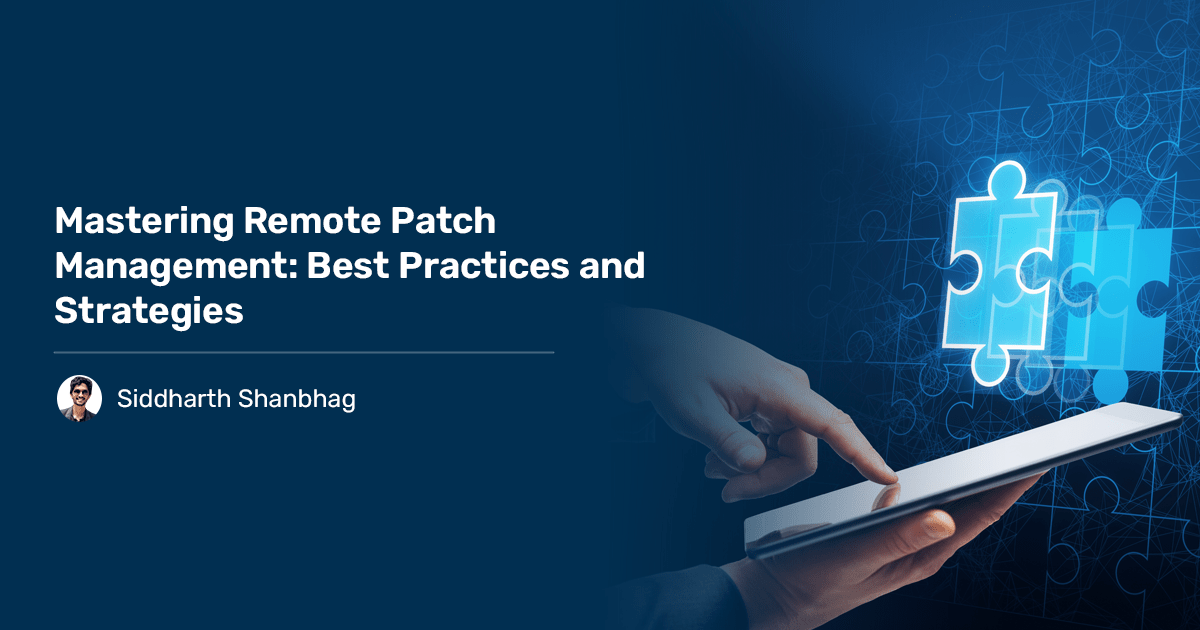In the fast-paced world of technology, where businesses are increasingly reliant on digital infrastructure, maintaining a secure and up-to-date software environment is paramount. Remote patch management emerges as a crucial aspect of this process, ensuring that software vulnerabilities are addressed promptly and efficiently. Remote patch management allows you to install patches and updates on any application, software, or device operating on or connected to a network from anywhere on the network.
A reliant patch management tool can help achieve remote patch management smoothly. In this blog post, we’ll explore the significance of remote patch management, its challenges, and the best practices to streamline the process for a seamless digital experience.
The Importance of Remote Patch Management
Remote patch management is essential for ensuring that all devices, including those outside the traditional corporate network, receive the latest security patches and software updates. With the rise of remote work, organizations must be able to manage and update software on devices regardless of their location. This is particularly crucial for maintaining a strong security posture and reducing the attack surface, as unpatched systems are a prime target for cyber threats. Here are several key reasons why remote patch management is important.
- Security Enhancement: Patch Management helps mitigate security vulnerabilities by making sure the systems are up to date with the latest security patches.
- Compliance Requirements: Many industries and organizations are subject to regulatory requirements and compliance standards that mandate timely patches of systems and software.
- Risk Reduction: Patch management reduces the overall risk exposure of an organization’s IT infrastructure.
- Cost Savings: Proactively managing patches and updates can help organizations avoid the costs. Associated with security incidents, system breaches, and compliance violations.
Challenges
One of the key challenges of remote patch management is ensuring that all devices are secure and up to date with the latest patches. This can be particularly complex when devices are located outside the corporate network. Additionally, not all remote patch management solutions are created equal, and choosing the right one can make all the difference in an organization’s security posture.
Addressing these challenges is crucial for maintaining the security and efficiency of an organization’s IT infrastructure. Remote patch management is associated with these key features:
- Distributed Workforce: The physical distribution of employees across different locations makes it challenging to maintain centralized control over patch deployment.
- Solution: Implementing remote patch management tools can handle devices in various locations. This ensures updates are applied seamlessly regardless of the employee’s geographical location.
- Endpoint Diversity: Remote work involves a mix of devices, operating systems, and software versions. Managing patches across diverse endpoints can be complex.
- Solution: Utilizing patch management tools that support a wide range of operating systems and applications. Ensuring comprehensive coverage for all devices within the organization.
- Security Risks: Some remote locations may have limited bandwidth. Making it challenging to download and install large patches without causing disruptions.
- Solution: Implementing a risk-based approach to patch management, prioritizing critical security patches. Ensuring they are deployed promptly to mitigate vulnerabilities and reduce the attack surface.
- Endpoint Visibility: Lack of visibility into the status of remote devices can hinder the ability to assess and manage patch compliance effectively.
- Solution: Utilize remote patch management tools to gain insights into the patch status of devices. Therefore, allowing administrators to identify and address non-compliant endpoints in real-time.
Best Practices for Remote Patch Management
- Automated Patching Solutions: Implementing an automated patching process helps streamline the process, reducing the likelihood of human errors and ensuring timely errors. These tools can schedule patches during non-disruptive hours, minimizing the impact on productivity.
- Prioritization of Critical Patches: Not all patches are created equal. Organizations must address critical patches that address security vulnerabilities and potential exploits. This risk-based approach ensures that the most pressing issues are addressed promptly.
- Regular Monitoring and Reporting: Continuous monitoring of patch deployment and regular reporting provide insights into the effectiveness of the patch management strategy. This allows organizations to identify potential issues and make necessary adjustments in real-time.
The Impact of Remote Work on Patching
The shift to remote work has significantly changed how organizations approach cybersecurity. With employees working from various locations, the need for effective patch management has become more critical than ever. Prompt deployment of patches is a fundamental part of any effective cybersecurity strategy. As unpatched systems remain a favourite target for cyber threats.
Remote patch management offers a solution to the challenges of manual patch management. It automates the entire patch management process, from identifying available patches to deploying them across your network. This automation saves time and effort, allowing your IT team to focus on more strategic tasks.
Conclusion
Mastering remote patch management is crucial for securing modern digital systems. However, by taking proactive steps, organizations can strengthen their defenses, reduce risks, and maintain smooth operations in today’s interconnected environment. Following the principles discussed here enables organizations to navigate remote patch management challenges successfully. Building a strong and secure digital foundation.


